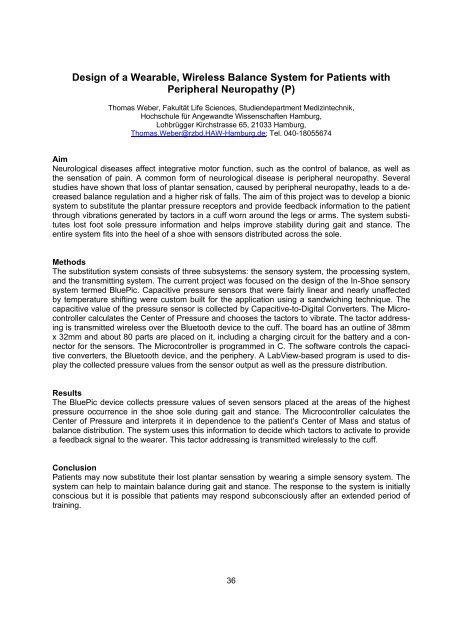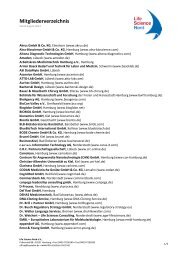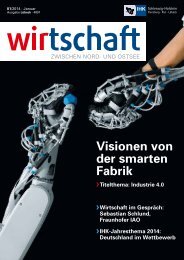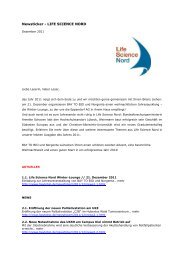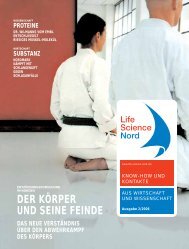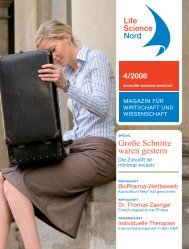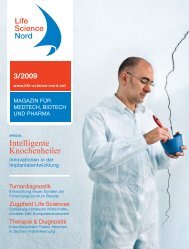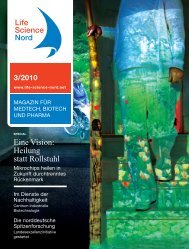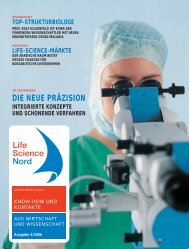Lebenslauf - Life Science Nord
Lebenslauf - Life Science Nord
Lebenslauf - Life Science Nord
Sie wollen auch ein ePaper? Erhöhen Sie die Reichweite Ihrer Titel.
YUMPU macht aus Druck-PDFs automatisch weboptimierte ePaper, die Google liebt.
Design of a Wearable, Wireless Balance System for Patients with<br />
Peripheral Neuropathy (P)<br />
Thomas Weber, Fakultät <strong>Life</strong> <strong>Science</strong>s, Studiendepartment Medizintechnik,<br />
Hochschule für Angewandte Wissenschaften Hamburg,<br />
Lohbrügger Kirchstrasse 65, 21033 Hamburg,<br />
Thomas.Weber@rzbd.HAW-Hamburg.de; Tel. 040-18055674<br />
Aim<br />
Neurological diseases affect integrative motor function, such as the control of balance, as well as<br />
the sensation of pain. A common form of neurological disease is peripheral neuropathy. Several<br />
studies have shown that loss of plantar sensation, caused by peripheral neuropathy, leads to a decreased<br />
balance regulation and a higher risk of falls. The aim of this project was to develop a bionic<br />
system to substitute the plantar pressure receptors and provide feedback information to the patient<br />
through vibrations generated by tactors in a cuff worn around the legs or arms. The system substitutes<br />
lost foot sole pressure information and helps improve stability during gait and stance. The<br />
entire system fits into the heel of a shoe with sensors distributed across the sole.<br />
Methods<br />
The substitution system consists of three subsystems: the sensory system, the processing system,<br />
and the transmitting system. The current project was focused on the design of the In-Shoe sensory<br />
system termed BluePic. Capacitive pressure sensors that were fairly linear and nearly unaffected<br />
by temperature shifting were custom built for the application using a sandwiching technique. The<br />
capacitive value of the pressure sensor is collected by Capacitive-to-Digital Converters. The Microcontroller<br />
calculates the Center of Pressure and chooses the tactors to vibrate. The tactor addressing<br />
is transmitted wireless over the Bluetooth device to the cuff. The board has an outline of 38mm<br />
x 32mm and about 80 parts are placed on it, including a charging circuit for the battery and a connector<br />
for the sensors. The Microcontroller is programmed in C. The software controls the capacitive<br />
converters, the Bluetooth device, and the periphery. A LabView-based program is used to display<br />
the collected pressure values from the sensor output as well as the pressure distribution.<br />
Results<br />
The BluePic device collects pressure values of seven sensors placed at the areas of the highest<br />
pressure occurrence in the shoe sole during gait and stance. The Microcontroller calculates the<br />
Center of Pressure and interprets it in dependence to the patient’s Center of Mass and status of<br />
balance distribution. The system uses this information to decide which tactors to activate to provide<br />
a feedback signal to the wearer. This tactor addressing is transmitted wirelessly to the cuff.<br />
Conclusion<br />
Patients may now substitute their lost plantar sensation by wearing a simple sensory system. The<br />
system can help to maintain balance during gait and stance. The response to the system is initially<br />
conscious but it is possible that patients may respond subconsciously after an extended period of<br />
training.<br />
36


